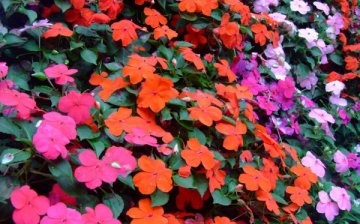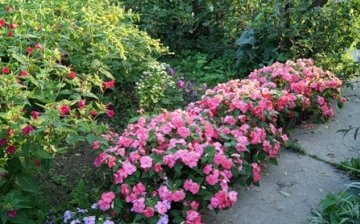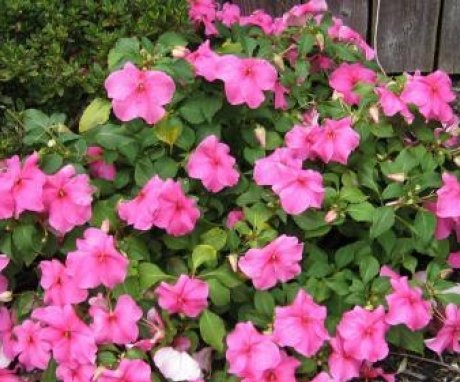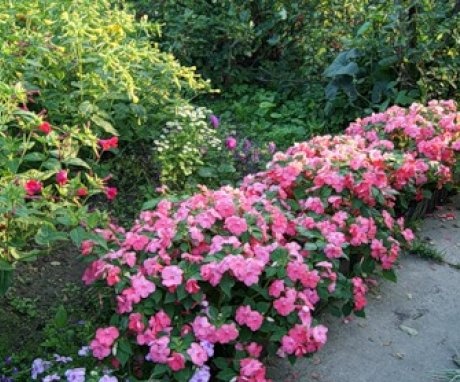Growing garden balsam
Garden balsam has come a long way from East Asia through America. And finally, in the middle of the 16th century, he came to Europe. From his room brother, he differs in appearance. Garden balsam has straight stems up to 70 cm high, along which flowers or inflorescences are located. The variety of colors of balsam is also pleasing: red, white, orange, pink, crimson, lilac, purple. The sizes of the flowers are quite large: up to 4 centimeters in diameter. Flowering lasts all summer until the first frost.
Content:
- Flower with many names
- Choosing a landing site
- Planting and breeding balsam
- Pruning and feeding balsam
- Plant use
- Pests and diseases
The peculiarity of balsam is the fragility of the stems. They break off at the slightest touch.
Flower with many names
The people gave many names to Balsamin. Among them - "Balsamic Touch", "Wet Roly", "Busy Lizzy", "Zealous Liza", "Beautiful Wreath".
The plant was named "touchy" due to the fact that its capsules containing seeds open at the slightest touch.
It is named "Vanka wet" because of the droplets that form on its leaves. These droplets have a sweet taste and are a favorite treat for ants. They appear when bad weather approaches. Therefore, the plant can be used as a living barometer.
The Englishmen call the plant "Lizzy", "the zealous Liza" - the Germans. The reason for these names was the long flowering of balsam.
The Austrians refer to the plant as the "beautiful wreath" because of its attractive appearance.
Choosing a landing site
Growing garden balsam does not require much effort: it is quite affordable for novice gardeners. The most suitable place for planting a plant is the east or west side.
Garden balsam has no particular preferences for soil, but it feels better on light, loose nutrient soils with good drainage. He does not like acidic soil.
Balsam is moisture-loving, but does not tolerate stagnant moisture, constant dampness and cold. Under these conditions, it sheds its leaves and stops flowering. But the plant cannot stand the intense heat, from which it withers.
Planting and breeding balsam
Before planting the plant, the soil must be treated with a fungicide. Plants are planted at a distance of 30 centimeters from each other.
Balsam is propagated by seeds, seedlings and cuttings.
Impatient seeds do not lose their germination for 8 years. The collected seeds are treated with potassium permanganate and sown in a substrate, for the preparation of which sand, humus, leafy soil and sod are used, taken in equal quantities.
The dishes with the sown seeds are covered with foil or glass and the temperature is maintained at + 20-25 degrees.
At temperatures below +20 degrees, the emergence of seedlings slows down or they do not appear at all.
The first shoots will appear in half a month. After the appearance of two leaves, young plants dive. Seedlings must be watered regularly, but not waterlogged, so as not to lead to infection with a black leg. Therefore, it is recommended to add vermiculite or perlite to the seedling substrate.
You can plant the seeds immediately in open ground.
For grafting, use the top of the plant. Cuttings root easily in water and soil. After 7-10 days, roots appear.And after 2-3 months, young plants will bloom.
Pruning and feeding balsam
The plant requires timely pruning. It promotes the formation of new shoots, which improves the bushiness and attractiveness of the plant, and also stimulates increased flowering. It is imperative to remove limp and damaged branches.
Garden balsam is quite responsive to feeding... It is recommended to alternate the application of organic and mineral fertilizers. Top dressing continues the duration of flowering. But it is necessary to use only complex mineral fertilizers.
If you feed the plant only with nitrogen fertilizers, then they will increase the green mass, but you will not see flowers.
But nitrogen fertilizers will have a positive effect on young plants. It is recommended to feed the plant 2 times a month.
Plant use
"Vanka wet" is able to decorate a flower bed, container, balcony.
This plant is also used in folk medicine. With a decoction of its leaves, wounds are washed, burns, ulcers, hemorrhoids and warts are treated, stones from the kidneys and bladder are removed. Alcohol tincture is used to relieve fatigue and headaches. But due to the toxicity of balsam, treatment should be very careful.
In Central Asia, a yellow-red paint is prepared from the roots of Impatiens.
People in many countries use the leaves, stems and seeds of balsam, which are rich in vitamin C, for food. They are said to taste like asparagus.
Pests and diseases
The cultivation of garden balsam is complicated by the plant's tendency to be affected by spider mites, aphids and whiteflies. It is worth taking a close look at any changes in the appearance of balsam: if they curl, this can signal illness or damage by a pest.
They fight pests with the help of chemicals or herbal infusions. For infusions use nasturtium, marigold, calendula.
Of the diseases, the plant is most often affected by powdery mildew.
Decay of stems and leaves indicates oversaturation of the soil with moisture.
A healthy balsam should have rich green leaves, even with a dark shade, and the flowers are large and bright. If you want to plant balsam next year, don't forget to collect the seeds!













